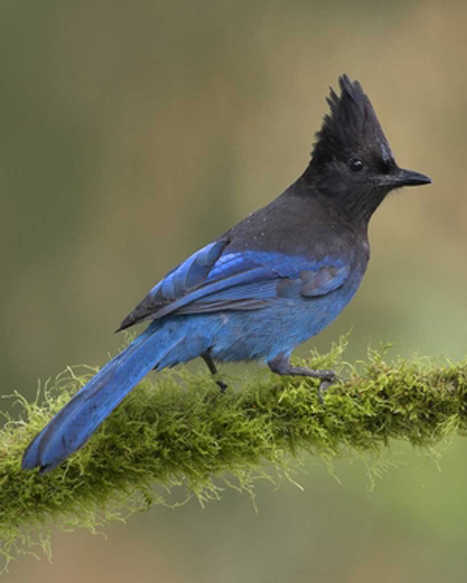A couple weeks ago, a small flock of Steller’s Jays flew across the Sterling Highway as I drove past the Welcome to Soldotna sign. Their dark bodies, crested heads, rounded wings, and long tails make them fairly easy to identify from a distance. On closer inspection, Steller’s Jays have a black head and vibrant blue body. My appreciation of Steller’s Jays began when I worked on the Tongass National Forest in southeast Alaska. I spent a summer playing a tape recording of Goshawk calls. The idea was that if Goshawks were nesting, they would fly in to investigate the sounds. I never saw a Goshawk during these surveys, but more times than I care to count, Stellar’s Jays flew in and tricked me by mimicking the recording. Many corvids, the family of birds to which jays belong, mimic sounds; cell phones, cat calls, and even human speech can be replicated by these birds.
Steller’s Jays, named by German naturalist Georg Wilhelm Steller, are very abundant in the coastal rainforest of Southeast Alaska. The Kenai Peninsula straddles the northwestern extent of the temporal coastal rainforest biome. Steller’s Jays are likely to be found in the wetter coastal portions of the Kenai Peninsula and have been found most winters in Homer since the Christmas bird count began in 1960. In contrast, Steller’s Jays only began to show up in Soldotna’s Christmas Bird Count in 2005. Over the past decade, a few Steller’s Jays are counted most years and their presence may be due to milder winters. However, they are still very uncommon in Soldotna.
Soldotna lies upon the Kenai Flats, the large flat area west of the Kenai Mountains, encompassing the southern extent of the boreal biome. The species historically found here are more typical of interior Alaska and the common jay species is the Gray Jay. Gray Jays, also known as camp robbers or whiskey jacks, are stocky birds colored light grey below and dark gray on the back with a partial black hood. Gray Jays are usually found in small flocks and even have the unusual habit of using nonbreeding adults to help with nesting.
Both types of jays are bold and curious. They like to investigate human activities to see what there is to eat — the nickname camp robber alludes to this behavior. Trappers can also attest to the curiosity of these birds. I often caught Steller’s Jays in the live traps that I used to trap and radio collar flying squirrels for a den study. Strangely, I had to release a Gray Jay “trapped” inside the grill of my Toyota Tacoma in the parking lot of Denali National Park. I can only guess that the jay was interested in an easy meal of smashed insects.
The range of both jays overlaps in a few areas including the Rocky Mountains and coastal Washington and Oregon. Not much is recorded about interactions between these species except that Steller’s Jays have been known to steal the food caches of many animals including Gray Jays. Ten years ago, I witnessed a flock of three Gray and two Steller’s Jays by the Kenai River. What appeared to be a juvenile Steller’s Jay was begging to be fed by an adult Gray Jay. This strange mixed flock moved off before I could observe more. This was the only time I have seen these species together. I will likely never know what was going on much less why or how. But, I do know that I am grateful to live on the Kenai Peninsula where we are lucky enough to experience both coastal rainforest and boreal forest species.
Dr. Dawn Robin Magness is a landscape ecologist and Fish & Wildlife Biologist at the Kenai National Wildlife Refuge.

